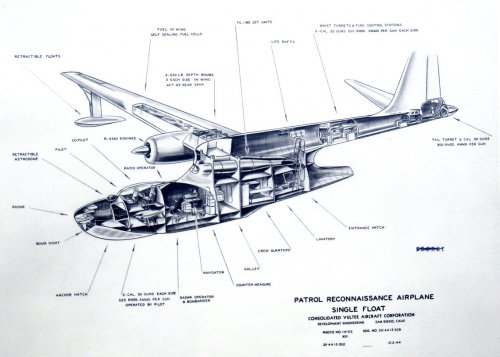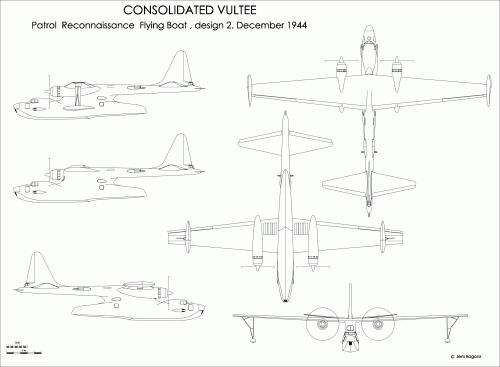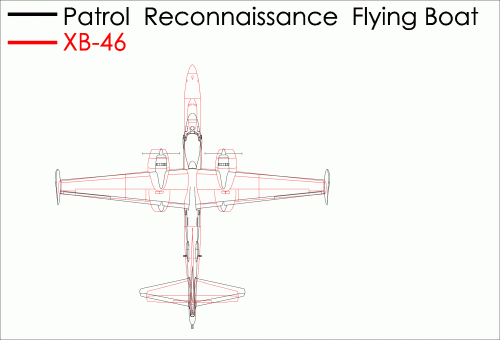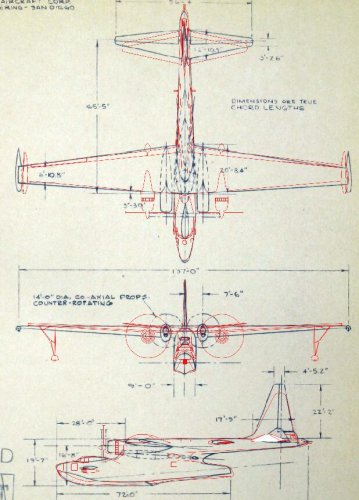You are using an out of date browser. It may not display this or other websites correctly.
You should upgrade or use an alternative browser.
You should upgrade or use an alternative browser.
Patrol Reconnaissance Airplane, Single Float
- Thread starter Orionblamblam
- Start date
- Joined
- 22 January 2006
- Messages
- 4,221
- Reaction score
- 2,032
Google as results give me only links to our forum !
We are the internet reference in unbuilt projects
it's true , the primary reference !pometablava said:Google as results give me only links to our forum !
We are the internet reference in unbuilt projects
- Joined
- 11 March 2006
- Messages
- 8,627
- Reaction score
- 3,817
Let's have a try with a lot of guess work and speculation. Dimensions can be estimated very
roughly by the size of the engines and to a lesser extent by the crew seats and waist gun positions,
which look very similar to those, installed in the Privateer, although looking slimmer here. Another
clue may have been the live rafts, but I couldn't find dimensions for them. Surely it would have been
a large aircraft, estimated length around 26m, span 35m, so in a class with the PB2Y Coronado, but
still smaller, than the Boeing XPBB-1 Sea Ranger. A detail not shown in the cut away is the cockpit.
Following the style of the (later) Tradewind, I've chosen a closed cockpit section with windows.
Would a framed glass house à la B-36 be more plausible ? Really don't know, here my decision was
based more or less on taste only. The bomb bays and their size were taken from the Coronado,
what puzzles me is the mention, that they were placed behind the rear spar, but maybe main and
rear spar were spaced very close.
As always, a drawing deduced from an perspective picture is rated as source grade 2 at best, no
guarantee for the correctness of dimensions and proportions !
roughly by the size of the engines and to a lesser extent by the crew seats and waist gun positions,
which look very similar to those, installed in the Privateer, although looking slimmer here. Another
clue may have been the live rafts, but I couldn't find dimensions for them. Surely it would have been
a large aircraft, estimated length around 26m, span 35m, so in a class with the PB2Y Coronado, but
still smaller, than the Boeing XPBB-1 Sea Ranger. A detail not shown in the cut away is the cockpit.
Following the style of the (later) Tradewind, I've chosen a closed cockpit section with windows.
Would a framed glass house à la B-36 be more plausible ? Really don't know, here my decision was
based more or less on taste only. The bomb bays and their size were taken from the Coronado,
what puzzles me is the mention, that they were placed behind the rear spar, but maybe main and
rear spar were spaced very close.
As always, a drawing deduced from an perspective picture is rated as source grade 2 at best, no
guarantee for the correctness of dimensions and proportions !
Attachments
Just a guess, but the shape of the wing and tail planform remind me of the XB-46, which IIRC should have been at the concept stage about this time. Perhaps looking at that design might be helpful in doing the what-if drawing. Also for scaling, the engine nacelle should give some clues, since the R-4360 type is specified.
Best Regards,
Artie Bob
Best Regards,
Artie Bob
alfakilo
ACCESS: Confidential
- Joined
- 18 October 2009
- Messages
- 74
- Reaction score
- 14
Jemiba said:Surely it would have been a large aircraft, estimated length around 26m, span 35m, so in a class with the PB2Y Coronado, but
still smaller, than the Boeing XPBB-1 Sea Ranger.
Yes...looking at the first picture, the waist and tail gunner positions seem out of scale when compared to the cockpit area. If these two were to be the better indicator of size, it would seem the airplane is of considerable size.
The use of jet engines is up for grabs. I looked up the TG-180 and found this:
http://wapedia.mobi/en/General_Electric_J35
Given the fuel consumption of these early jets, I'm unsure of how these engines would have contributed to the 'patrol' mission.
- Joined
- 25 June 2009
- Messages
- 14,767
- Reaction score
- 6,197
What really bugs me in all these images, whether original or reworks, is the purpose and advantages of such a complicated configuration, compared to a more traditional fuselage with high wing and wing-tip jets. Any idea, someone?
thanks Jemiba! B)Jemiba said:Let's have a try with a lot of guess work and speculation. Dimensions can be estimated very
roughly by the size of the engines and to a lesser extent by the crew seats and waist gun positions,
which look very similar to those, installed in the Privateer, although looking slimmer here. Another
clue may have been the live rafts, but I couldn't find dimensions for them. Surely it would have been
a large aircraft, estimated length around 26m, span 35m, so in a class with the PB2Y Coronado, but
still smaller, than the Boeing XPBB-1 Sea Ranger. A detail not shown in the cut away is the cockpit.
Following the style of the (later) Tradewind, I've chosen a closed cockpit section with windows.
Would a framed glass house à la B-36 be more plausible ? Really don't know, here my decision was
based more or less on taste only. The bomb bays and their size were taken from the Coronado,
what puzzles me is the mention, that they were placed behind the rear spar, but maybe main and
rear spar were spaced very close.
As always, a drawing deduced from an perspective picture is rated as source grade 2 at best, no
guarantee for the correctness of dimensions and proportions !
SlickDriver
ACCESS: Confidential
- Joined
- 20 June 2006
- Messages
- 161
- Reaction score
- 35
Madurai said:I'm fascinated by the "counter-measure" station. Chaff, or some 1944-vintage jammer?
During WWII the British codename was Window. The US developed a machine that cut strips of aluminum foil to match 1/2 the wave length of the detected radar.
http://en.wikipedia.org/wiki/Window_%28codename%29
- Joined
- 11 March 2006
- Messages
- 8,627
- Reaction score
- 3,817
"wing and tail planform remind me of the XB-46"
Excellent idea, Artie ! Of course, I may just be a family resemblance, but it even
matches the positions of the engines quite well,so maybe components were "recycled".
For determining the size, I used the nacelles of the Fairchild C-119 and of the B-50.
The configuration in itself reminds me of the Blohm & Voss Bv 138. Advantages may be,
that the tail isn't as prone to spray and damage by waves, as in a conventional configuration.
The additional jet engines probably should have been used for dash speed during attack
runs, apart from augmenting the piston engines during take-off. Auxiliary jets were proposed
for several other patrol aircraft during the late '40s/'50s,too. just remember the numerous
french designs like the Latécoère 221 to 228, or the SNCASE X-108.
Excellent idea, Artie ! Of course, I may just be a family resemblance, but it even
matches the positions of the engines quite well,so maybe components were "recycled".
For determining the size, I used the nacelles of the Fairchild C-119 and of the B-50.
The configuration in itself reminds me of the Blohm & Voss Bv 138. Advantages may be,
that the tail isn't as prone to spray and damage by waves, as in a conventional configuration.
The additional jet engines probably should have been used for dash speed during attack
runs, apart from augmenting the piston engines during take-off. Auxiliary jets were proposed
for several other patrol aircraft during the late '40s/'50s,too. just remember the numerous
french designs like the Latécoère 221 to 228, or the SNCASE X-108.
Attachments
Jemiba said:Let's have a try with a lot of guess work and speculation.
Boy howdy, you sure went to a lot of trouble sketching up something I have a 3-view, inboard profiles, artwork and data tables for...
You got suprisingly close for the most part. Dead wrong on others...
PS: The other stuff is going onto my blog at some point. Just a little busy at present, though.
- Joined
- 11 March 2006
- Messages
- 8,627
- Reaction score
- 3,817
"...sketching up something I have a 3-view"
I thought as much ! But it's always a good way to check methods and at least trying to avoid making
the same mistakes again and again. You know, I'm searching for the ultimate
tool for reconstructions from perspective pictures, still yet without complete
success, so there's no other way than : training, training !
And as we still know from our years at school: Who calculates again an arithmetic
problem, if the result is already known ? ;D
In this case, I had the feeling, the length of the tail boom is over emphasized in
the cut away ? With my method of slicing and progressively increasing, I didn't
get plausible results.
So, I'm waiting for your blog !
I thought as much ! But it's always a good way to check methods and at least trying to avoid making
the same mistakes again and again. You know, I'm searching for the ultimate
tool for reconstructions from perspective pictures, still yet without complete
success, so there's no other way than : training, training !
And as we still know from our years at school: Who calculates again an arithmetic
problem, if the result is already known ? ;D
In this case, I had the feeling, the length of the tail boom is over emphasized in
the cut away ? With my method of slicing and progressively increasing, I didn't
get plausible results.
So, I'm waiting for your blog !
Jemiba said:So, I'm waiting for your blog !
It's there. Enjoy.
- Joined
- 11 March 2006
- Messages
- 8,627
- Reaction score
- 3,817
Ok, let's see:
The spacing of the engines is completely wrong, as is the width of the cockpit ...
and my taste seems to be wrong, too, as the canopy actually IS of the greenhouse
type, isn't it ? Although the necessity of an astrodome isn't quite clear to me then.
And the pylon, containing the jet engines has the same width as the boat.
And the dimensions, bah, I just them wrong by farcical 20 to 24 % ! :-[
But squeezing the engines into such elliptically bent nacelles, I really should regard as
a personal insult, no similarity at all to the C-119 or the B-50. ;D
So, I was still producing cast pieces with a hammer. :-\
But many thanks for showing this design, Scott ! We learn something new every day !
The spacing of the engines is completely wrong, as is the width of the cockpit ...
and my taste seems to be wrong, too, as the canopy actually IS of the greenhouse
type, isn't it ? Although the necessity of an astrodome isn't quite clear to me then.
And the pylon, containing the jet engines has the same width as the boat.
And the dimensions, bah, I just them wrong by farcical 20 to 24 % ! :-[
But squeezing the engines into such elliptically bent nacelles, I really should regard as
a personal insult, no similarity at all to the C-119 or the B-50. ;D
So, I was still producing cast pieces with a hammer. :-\
But many thanks for showing this design, Scott ! We learn something new every day !
Attachments
- Joined
- 18 March 2008
- Messages
- 3,529
- Reaction score
- 999
Stargazer2006 said:What really bugs me in all these images, whether original or reworks, is the purpose and advantages of such a complicated configuration, compared to a more traditional fuselage with high wing and wing-tip jets. Any idea, someone?
Well the fundamental configuration design of the PBY Catalina flying boat was the parasol wing – a wing not directly mounted on the fuselage – which enabled the propellers to be far enough from the water to spin freely and the boat hull to be short enough to not be super draggy. The alternative with most flying boats is to have a very deep boat hull which adds lots of drag.
Now the bit of the fuselage that connects the hull to the parasol wing is the pylon and is otherwise wasted volume. The PBY sticks the flight engineer in here to make some use of it – and they get a good view of the engines – but on the “Jet Catalina” the pylon is used for a couple of turbojets. This configuration utilises existing structure to do two roles: join the hull to the wing and mount the jets. Otherwise additional structure weight and drag would be needed to attach the jets to the wing.
It’s a very elegant solution and a wonderful looking airplane. A great find Orion, great find.
Similar threads
-
Lockheed V-156 Jet Patrol Airplane Project of 1944
- Started by jzichek
- Replies: 6
-
Aichi Experimental Two-Seat Reconnaissance Seaplane (AM-10)
- Started by blackkite
- Replies: 0
-
Consolidated-Vultee XA-44 (MX-423 and MX-716)
- Started by Clioman
- Replies: 8
-
IJN Specification 12-Shi (E12/E13, Reconnaissance Seaplane, 1937)
- Started by blackkite
- Replies: 25
-




